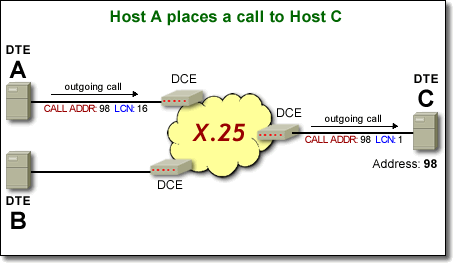|
ZiP X.25 PAD –
International Standard Conformance: X.3, X.28, X.29, X.25, X.121 |
|
|
|
|
|
|
|
Overview
The ZipPAD is a packet assembly/disassembly X.25 device (PADs). The primary functions of a PAD are to exchange information via data packet form with a remote PAD in the X.25 packet switch network, and to convert these data packet information to be a data character stream to the asynchronous equipment and vice versa. PAD works with local or remote asynchronous (by using modem) terminals and uses the synchronous modem, such as DSU, to connect to the X.25 packet network. In addition to mentioned above, it can be treated as concentrator or multiplexer
The ZipPAD , with its "extended PAD management functions and system commands", can be fully configured from any local or remote asynchronous terminal through a leased or dial-up line. These enhanced functions make your ZipPAD be easily handled and controlled. Its security is that the supervisor is only allowed to operate or use the extended PAD management functions and system commands.
The ZipPAD be easily connected to any public switching data network (PSDN) or private packet-switching network (PPSN). The ZipPAD can be specified to be a DTE or a DCE , and be back-to-back setting.
The ZipPAD provides a X.25 synchronous port or two optionally. These dual ports work in load-sharing mode, or in backup mode, or in fixed routing mode to improve performance and to enhance reliability.
The ZipPAD provides multiple architectures that meets your business needs. ZipPAD series, from PC's synchronous card , personal PAD to enterprise, with variable asynchronous ports to fit into your business needs.
|
Feature List
- Standards: CCITT Data Link Layer, Packet Layer
- International Standard Conformance: X.3, X.28, X.29, X.25, X.121
- High quality, high speed (up to 64Kbps, ISDN B channel).
- High Reliability
- PVC, SVC online setting
- Major international PDNs certified.
- Extended PAD management functionss
- Status monitoring
- Call record log
- Traffic statistics/trace
- Port state control
- Remote management
- Password protection.
- Transparent to most popular PC communication software
- Support terminal emulation, file transfer, E-mail etc..
- Modem signal controls for leased or dial-up operations.
- Number of terminal ports extensible.
|
Technical Specification
Hardware |
| CPU |
Intel 80188 |
| HDLC Controller |
Z8530/8MHz, V.35/ RS449 (optional) |
Input/output Interface |
| Synchronous Ports |
1 or 2 |
| Asynchronous Ports |
2 or 4 or 8 |
| Interface |
V.24/RS232, V.35/RS449 (optional) |
| Truck Speed |
64Kbps |
| Clocking |
Internal or External |
| Connection |
Leased or Dial-up modem |
Link Level |
| Framing |
LAPB/HDLC |
| Addressing |
DTE or DCE |
| Numbering |
Modulo 8 or Modulo 128 |
| Parameters |
K:1 to 127, N1:21 to 4101 octets T1, T2, T3:100ms to 25 sec |
Packet Level |
| Service |
PVC and/or SVC |
| Address Format |
ITU-T X.121, 15 digits |
| Packet Size |
16 to 4096 octets |
| Flow Control Nego |
Yes |
| Window Size |
1 to 127 |
| Q/D/M Bits |
Supported |
| Parameters |
T20=180, T21=200, T22=180, T23=180 |
Software |
| ITU-T X.25 |
Fully Support |
| ITU-T X.3/X.28/X.29 |
fully supports |
| Security |
password protection |
| Traffic Statistics |
supported |
| On-Line Help |
supported |
| Traffic Trace |
supported |
| Protocol Monitor |
supported |
Mechanical |
| Temperature |
Operating 0 Celsius to 70 Celsiu |
| Dimensions |
234 x 164 x 40 mm |
| Relative Humidity |
Operating 10% to 85% |
| Certification |
FCC part 15 class A; Telenet, USA; Pacnet DCI, Taiwan |
|
Application Graph

|
|